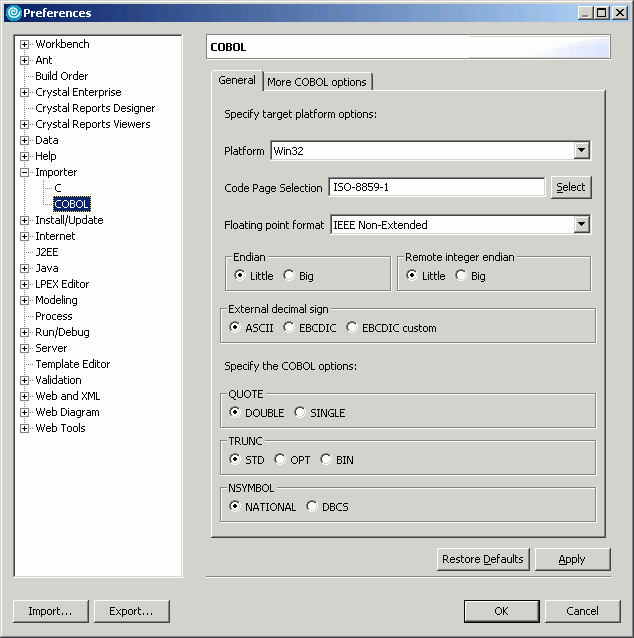Setting PL/I Importer Preferences
You can set the PL/I importer preferences for an individual
file import through the J2C wizard, or you can change the default
compiler options using the PL/I importer preference page.
Procedure
- Select Window > Preferences.
- Expand the Importer option and select PL/I under the General tab. The
following parameters can be modified:
Parameter Options Description Platform - Win32
- Z/OS
- Not specified
The platform on which the PL/I program runs. Selecting a platform sets the other platform Information attributes to default values that are appropriate for that platform. Code page The Codepage of the PL/I program. Enabling IMS Support - Checked
- Cleared
The length field is recognized by the following rule: - The name of the field is 'LL'.
- The attribute of field is 4 bytes integer, declared as FIXED BIN(31).
- The first field of the IMS message structure.
CICS® Version - None - No CICS translator is used when importing PL/I source
- CICS Transaction Server for z/OS® v3.1 - CICS v3.1 translator is used when importing PL/I source.
- CICS Transaction Server for z/OS v3.2. - CICS v3.2 translator is used when importing PL/I source.
The option to enable CICS translation. Selecting this option allows you to select the type of CICS translation you want, if any. Error message language Default: US English The language of error messages of PL/I compiler. DBCS option NODBCS The NODBCS option causes the listing to show all DBCS shift-code as ".". DBCS The DBCS option ensures that the listing is sensitive to possible presence of DBCS. GRAPHIC option NOGRAPHIC The NOGRAPHIC options specify that the source program does not contain double-byte characters. GRAPHIC The GRAPHIC options specify that the source program can contain double-byte characters. The hexadecimal codes '0E' and '0F' are treated as the shift-out and shift-in control codes, wherever they appear in the source program, including occurrences in comments and string constants. File extension support Using this table, the user can change the default extension behavior. that is, they can assign an extension to - contain a full program or data structures only. - To change the advanced PL/I compiler preferences, select
the More PL/I options tab. The following parameters
can be modified:

Parameter Options Description LIMITS NAME This option specifies the maximum length of variable names in your program. EXTNAME This option specifies the maximum length for EXTERNAL name. FIXEDBIN This option specifies the maximum precision for SIGNED FIXED BINARY to be either 31 or 63. FIXEDDEC This option specifies the maximum precision for FIXED DECIMAL. Margins Left. The column number of leftmost character that is processed by the compiler. Right The column number if rightmost character that is processed by the compiler. GRAPHIC The GRAPHIC options specify that the source program can contain double-byte characters. The hexadecimal codes '0E' and '0F' are treated as the shift-out and shift-in control codes, wherever they appear in the source program, including occurrences in comments and string constants. Macro preprocessor NOMACRO The NOMACRO option not invokes macro preprocessor. MACRO The MACRO option invokes the macro preprocessor. SYSPARM The SYSPARM option allows you to specify the value of the string that is returned by the macro facility built-in function SYSPARM. Character Conversion BLANK The BLANK option specifies up to 10 alternate symbols for the blank character. CURRENCY The CURRENCY option allows you to specify an alternate character to be used in picture strings instead of the dollar sign. NOT The NOT option specifies up to seven alternate symbols that can be used as the logical NOT operator. OR The OR option specifies up to seven alternate symbols as the logical OR operator. These symbols are also used as the concatenation operator, which is defined as two consecutive logical OR symbols. NAMES The NAMES option specifies the extralingual characters that are allowed in identifiers. Extralingual characters are those characters other than the 26 alphabetic, 10 digit, and special characters defined in PL/I Language Reference.
- Enabling IMS Support
If the PL/I source file that you use in your application is for an IMS application, you need to select Enable IMS Support in the PL/I importer preferences.
Feedback